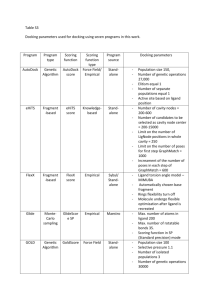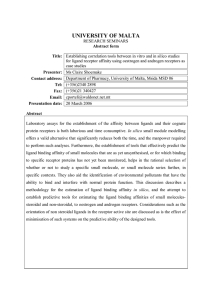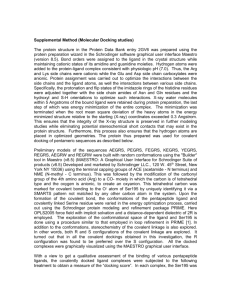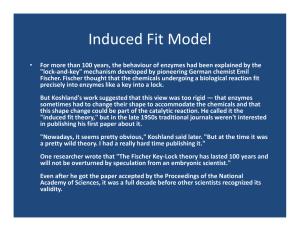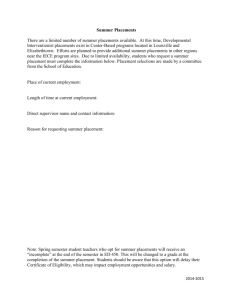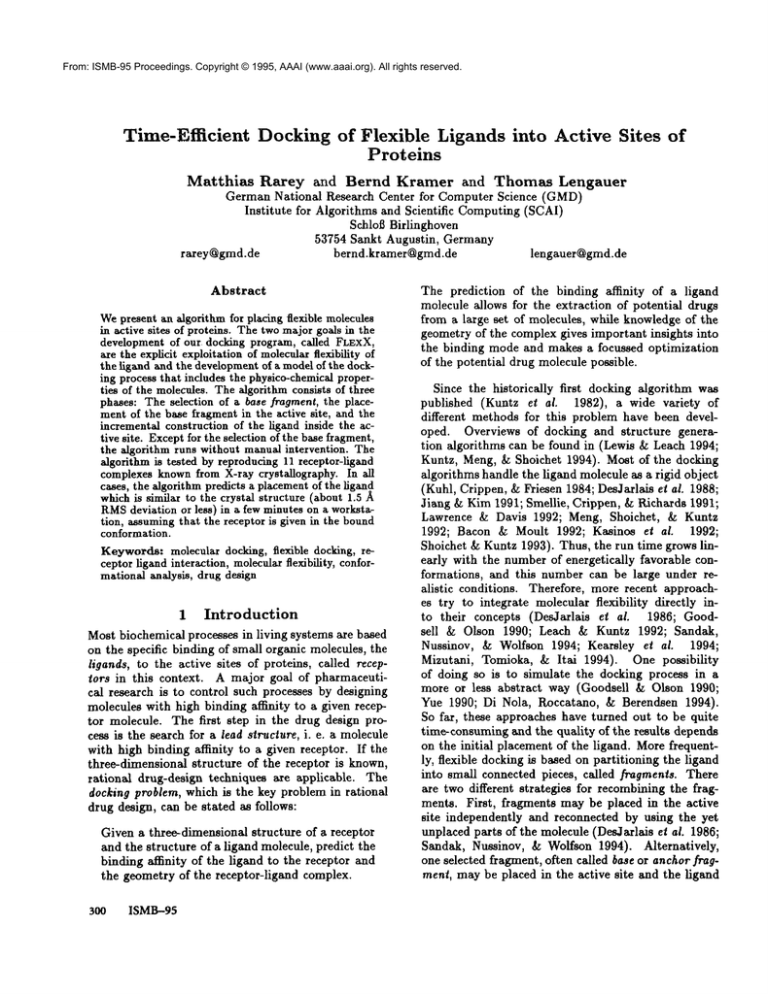
From: ISMB-95 Proceedings. Copyright © 1995, AAAI (www.aaai.org). All rights reserved.
Time-Efficient
Docking of Flexible Ligands into Active Sites
Proteins
of
Matthias Rarey and Bernd Kramer and Thomas Lengauer
GermanNationalResearchCenterfor ComputerScience(GMD)
Institute
forAlgorithms
andScientific
Computing
(SCAI)
Schlofl
Birlinghoven
53754SanktAugustin,
Germany
rarey@gmd.de
bernd.kramer@gmd.de
lenganer@gmd.de
Abstract
Wepresent ~ algorithm for placing flexible molecules
in active sites of proteins. The two majorgoals in the
development of our docking program, called FLExX,
are the explicit exploitation of molecularflexibility of
the li$~nd ~nd the developmentof a modelof the docking process that includes the physico-chemicalproperties of the molecules. The algorithm consists of three
phases: The selection of a base fragment, the placement of the base fragment in the active site, a~d the
incremental construction of the ligand inside the active site. Exceptfor the selection of the base fragment,
the algorithm runs without manualintervention. The
algorithm is tested by reproducing11 receptor-ligand
complexes knownfrom X-ray crystallography. In all
cases, the algorithmpredicts a placementof the ligand
which is similar to the crystal structure (about 1.5
RMS
deviation or less) in a few minutes on a workstation, assumingthat the receptor is given in the bound
conformation.
Keywords:molecular docking, flexible docking, receptor ]igand interaction, molecularflexibility, conformational analysis, drug design
1 Introduction
Most biochemical processes in living systems are based
on the specific binding of small organic molecules, the
ligands, to the active sites of proteins, called receptors in this context. A major goal of pharmaceutical research is to control such processes by designing
molecules with high binding affinity to a given receptor molecule. The first step in the drug design process is the search for a lead structure, i. e. a molecule
with high binding affinity to a given receptor. If the
three-dimensional structure of the receptor is known,
rational drug-design techniques are applicable. The
docking problem, which is the key problem in rational
drug design, can be stated as follows:
Given a three-dimensional structure of a receptor
and the structure of a hgand molecule, predict the
binding affinity of the ligand to the receptor and
the geometry of the receptor-ligand complex.
3OO ISMB-95
The prediction
of the bindingaffinityof a ligand
molecule
allowsfortheextraction
of potential
drugs
froma largesetof molecules,
whileknowledge
of the
geometry
of thecomplex
givesimportant
insights
into
the bindingmodeandmakesa focussedoptimization
of thepotential
drugmolecule
possible.
Since the historically first docking algorithm was
published (Kuntz et ai. 1982), a wide variety of
different methods for this problem have been developed. Overviews of docking and structure generation algorithms can be found in (Lewis & Leach 1994;
Kuntz, Meng, & Shoichet 1994). Most of the docking
algorithms handle the hgand molecule as a rigid object
(Kuhl, Crippen, & Priesen 1984; DesJarlais el al. 1988;
Jiang & Kim1991; Smellie, Crippen, & Richards 1991;
Lawrence & Davis 1992; Meng, Shoichet, & Kuntz
1992; Bacon & Moult 1992; Ka~inos el al. 1992;
Shoichet & Kuntz 1993). Thus, the run time grows linearly with the number of energetically favorable conformations, and this number can be large under realistic conditions. Therefore, more recent approaches try to integrate molecular flexibility directly into their concepts (DesJarlais el al. 1986; Goodsell & Olson 1990; Leach & Kuntz 1992; Sandak,
Nussinov, & Wolfson 1994; Kearsley el al. 1994;
Mizutani, Tomioka, & Itai 1994). One possibility
of doing so is to simulate the docking process in a
more or less abstract way (Goodsell & Olson 1990;
Yue 1990; Di Nola, Koccatano, & Berendsen 1994).
So far, these approaches have turned out to be quite
time-consuming and the quality of the results depends
on the initial placement of the ligand. More frequently, flexible docking is based on partitioning the ligand
into small connected pieces, called fragments. There
are two different strategies for recombining the fragments. First, fragments may be placed in the active
site independently and reconnected by using the yet
unplaced parts of the molecule (DesJarlais el al. 1986;
Sandak, Nussinov, & Wolfson 1994). Alternatively,
one selected fragment, often called base or anchor fragment, may be placed in the active site and the ligand
reconstructed inside the active site incrementally starting with the base fragment (Leach & Kuntz 1992).
The overall goal of our research is to develop a software tool for docking that is fast and reliable.
Wewant the tool to be fast enough to allow for docking large sets of ligands into a given receptor pocket
within a matter of hours (as part of a search over
database of ligands) or suggesting alternative conformations for docking a single ligand within a matter of
minutes (for interactive dialogs at a workstation). The
reliability of the output is a little harder to quantify.
We do not believe that, with the methods and computers available today, it is possible to give accurate
estimates of free energy of a representative set preferred binding modes within a matter of minutes on a
workstation. However, we require that the tool compute a representative set of low-energy binding modes.
Furthermore these binding modes should be ranked approximately accurately with respect to free energy. Finally, the 3d-coordinates of the binding modesshould
be accurate to within the limits of the error involved
in experimental measurements (roughly up to 1A rms
deviation).
In order to achieve these goals, we employthe incremental construction strategy that was originally developed for de-novo design of ligands (Moon & Howe
1991). With the receptor held rigid, we model the more
essential flexibility of the ligand explicitly. Geometric
and physico-ehemical properties of the molecules are
modeled explicitly, as well, and only chemically meaningful placement of the ligand are generated.
For the sake of speed, we developed a new algorithm
for placing the base fragment, and a number of timeand space-efficient techniques for the incremental construetion process. Instead of using time-consuming
force-field calculations, we base the scoring of the
(partial) placements on a variation of tt.-J. BShm’s
empirical energy function (BShm 1994) designed for
the structure
generation tool LUDI (BShm 1992a;
1992b). Therefore, we are able to give a rough estimate of the binding alTmity, in addition to computing
the geometry of the complex.
Apart from the selection of the base fragment, our
tool works without manual intervention. Up to date,
we have successfully tested our tool on 11 docking examples. The run times are within a few minutes on a
SUNSPARCstation 20. We are constantly increasing
our test set, in order to make the tool more reliable.
The following section describes the chemical modeling in FLEXX.Section 3 contains a brief description
of the algorithms and data structures that FLEXX
uses. The last section gives a summaryof the results
obtained with our docking tool.
2 The chemical
modeling
in FLEXX
Receptor structures The first part of the input for
the docking problem is the three-dimensional conformation of the receptor, especially, of the active site.
FLEXXgets this information from a standard PDB
file (Bernstein et al. 1977) and a user-defined receptordescription file. The active site must be identified by
the user. This only weakly diminishes the power of
our approach, because we use FLExXas an element
of a software-package that includes tools and databases for predicting and storing geometries of active sites.
The receptor-description file contains the assignment
of amino acid templates to the receptor. The templates contain atom and bond types, possible interacting groups and the numbers and relative positions of
polar hydrogen atoms.
Ligand structures We model the flexibility
of the
ligand by allowing for a finite set of torsion angles for
each freely rotatable single bond and finite sets of lowenergy conformations for each ring system inside the
ligand. All remaining torsion angles inside the ligand
as well as its bond angles and bond lengths are taken from an energy-minimized conformation of the ligand. In order to assign finite sets of torsion angles
to each single bond, FLI~XXuses data of a statistical
analysis of the CSDB(Allen et ai. 1979) generated by
G. Klebe for the conformational search program MIMUMBA
(Klebe & Mietzner 1994). The calculation
of the structure and the strain energy of the possible
conformations of ring systems is carried out with the
QCPEprogram SCA (Hoflack & De Clercq 1988). Only conformations with energies lying below the threshold of 20 kJ/mol (relative to the observed minimum)
are chosen.
Molecular interactions
The receptor-ligand
interaction is modeledby a few special types of interactions.
These are hydrogen bonds, metal-acceptor bonds and
a few types of hydrophobic contacts (see Table 1).
interaction is modeled by an interaction center and an
interaction surface located on a sphere around the center (fig. 1). An interaction between two groups A and
B occurs, if the interaction center of group B lies on the
interaction surface of group A and vice versa (fig. 2).
In FLEXX
the interaction surfaces in the receptor are
modeledby sets of discrete interaction points.
Furthermore, a repulsive interaction between receptor and ligand is implicitly taken into account by the
clash tests which FLEXX
performs in order to eliminate
placements with large overlap volumes. Weuse vander-Wa~ls radii from Pauling (Pauling 1939) in combination with a united atom model, and set the thresholds for individual atom-atom overlaps to 2.5As and
s.
for the average atom-atom overlaps to 1.0A
Rarey
3Ol
a
b
Figure 1: Interaction surface of a carbonyl group (a),
and the three different types of interaction surfaces
that axe sections of a sphere: cone, cone section, spherical rectangle (b).
As mentioned above, FLEXXuses a function similar to that developed by H.-J. B6hm(BShm1994)
order to score the placements and to estimate the free
binding energy AGof the protein-ligand complex.
AG
=
AGo + AGro,× N~ot
+ Aahb
neutral
~
I(zxR,,x~)
Figure 2: Hydrogen bond between a carbonyl oxygen
and a nitrogen. The interaction occurs, if the interaction centers (oxygen and hydrogen atom) lie on the
interaction surface of the counter group.
Here, ARis the difference of the distance between the
atoms centers and the sum of both van-der-Waals radii,
each increased by 0.3/~.
Finally it should be mentioned that the energy function does not take into account any explicit intramolecular interaction. Weimplicitly account for such a term
by dropping all ligand conformations with unfavorable
torsion angles or ring conformationsor internal clashes.
H-bonds
3 The FLEXXalgorithm
FLEXXfollows an incremental construction
which consists of three phases:
ionic int.
+ Aaz,po F_, f’(AR)
lipo. corot.
+ aaaro
(1)
aro int.
Here, f(AR, Aa) is a suitable function and Nro,
counts the free rotatable bonds that are hindered in the
complex. The terms AGhb, AGio, AG~ot, and AGo are
gaugeable parameters. These values and the function
f are taken from B6hm.Howeverthe lipophilic contact
term has been changed and the last term is a new and
takes into account the interactions of aromatic groups
(with the new parameters AGupo= -0.34kJ/mol and
AGaro = -0.TkJ/mol).
The lipophilic contact energy term of B6hmis intended to be proportional to the lipophilic contact
area. B6hmestimates this area with a grid method.
However, our preliminary investigations with this notion of contact energy have generated placements that
deviate markedly from the crystal structure. Therefore, we chose to calculate this term over a sum of
pairwise atom-atom contacts, instead. It is important
that the function f* (AR) in (1) penalize forbiddingly
close contacts. Because of that, we choose:
i
f’(AR)--
302
ISMB--95
AR< 0.2~
1 zxa-o.~
AR < 0.6A
0.4
AR > 0.6A
0
strategy,
Base selection The first phase of the docking algorithm is the selection of a connected part of the ligand, the base fragment.
Base placement The base fragment is the part of the
ligand, which is placed into the active site first and
independently of the rest of the ligand. This is done
in the second phase, the so-called base placement
phase.
Construction In the last phase, the ligand is constructed in an incremental way, starting with the different placements of the base fragment. This phase
is called the construction phase.
In the current version of FLEXX,the base selection is
not automated; it must be done interactively
by the
user of the docking tool. The base fragment selection
involves a tradeoff between two properties of the fragments. On the one hand, the base fragment should
have a large set of interacting groups, such that a placement of the fragment into the active site can be found.
On the other hand, the number of low-energy conformations of the base fragment should be small, because
each conformation must be considered separately in
the base placement phase.
Placing
the base fragment
3.1
The fragment placing algorithm is based on a technique from the area of pattern recognition, called
Type of interaction
group
H-bond donors
metal ions
H-bond or
acceptors
metal-ion
Example
Geometry
O-H
N-H
2+
Zn
C=O in COOC=Q, S=O,
V=O
R-O-H
R20, RaN
cone
cone
sphere
two spher, rect.
cone
aromatic groups
groups interacting
with aromatic groups
aromatic
groups
methyl group
amide group
Center of sphere
(section)
H
H
Zn
O
O
two spher, rect.
cone
two cones above
and below plane
cone
O
O, N
center of the ring
sphere
two cones above
and below plane
C
middle
bond
H
of
C-N
Table 1: A few examples of the different interaction type groups and their geometric requirements (see fig. 1). (For
the complete list and the quantitative data of the surfaces please contact the authors)
pose clustering (Linnainmaa, Harwood, & Davis 1988;
Olson 1994). The basic idea of the algorithm is the
following: A transformation of a fragment in a given conformation into the active site of the receptor is
determined by three simultaneously occurring interactions between the fragment and the receptor (see fig.
3). Thus, the algorithm considers each triple of interaction centers (qD, ql, q~) in the fragment and searches
for triples of interaction points (P0, Pl, P~) in the active
site with the following three properties:
1. The interaction types of qi and Pi are complementary, i.e., an interaction betweenqi and Pi is chemically meaningful, for i = 0, 1, 2.
2. The pairwise distances between the interaction centers and the interaction points are nearly equal,
i.e. I IIqi- qi+xmod3[I-- lips - P++lmodall
[ < 6, for
i = 0,1,2. Here, 6 is a parameter describing the
tolerance in the matchin$ step.
3. After the fragment is placed on the interaction
points, the additional angular constraints at the ligand’s interaction groups are valid.
A pair of triangles, whichfulfill the first two properties
is called 6-compatible.
In principle, a fragment may form more than three
interactions.
Thus, a subsequent clustering step is
needed, which merges similar transformations of the
fragment to a single resulting placement (see fig. 4).
Finally, each remaining placement computed is tested for overlap with the receptor. The non-overlapping
placements are ranlred by their decreasing free energy
of binding, as estimated by the algorithm.
Figure 3: The fragment placing algorithm: mapping
three interaction centers (grey spheres) of the hgand
onto three discrete interaction points in the active site
(black dots) defines a unique transformation of the ligand into the active site.
The approach contains two algorithmic parts, which
we consider in more detail: the search for similar triangles in three-dimensional space and the clustering of
transformations for the fragment.
Matching: searching for similar triangles
During the first part of the fragment placing algorithm, a
search for all 6-compatible triangles (P0, Pl, P2) of interaction points must be performed for each triangle
(qo, qt,q2) of interaction centers of the fragment. In
a naive approach, the search time is O(ms) for each
triple of interaction centers, where mis the number of
interaction points in the active site. This time can be
reduced by precomputing all possible triangles and using the interaction types and edge lengths in order to
address the triangle in a hash table. Under the practical assumption that the access of the triangles via
a hash function needs O(1) time, the run time of the
RarcT
303
~’-,~lke//4
operation
4~x
/~
4
/
~__~
Figure 4: Merging initial
placements: Two initial
placements with different sets of interactions but similar transformations Cleft) will be combined to one
placement (right) by merging the sets of interactions
and recomputing a transformation.
search is proportional to the number of &compatible
triangles retrieved and is asymptotically optimal. Nevertheless, the preprocessing time and storage requirement increases to O(m3), which is too large for practical cases.
Wehave developed a data structure for the triangle searching problem which needs O(m~) storage and
is as fast as the triangle hashing method, in practice.
Instead of storing each triangle, each line segment is
precomputed and stored in a table. Let (PO,Pl) be a
line segment, consisting of two interaction points with
interaction types t(pi), i = 0, 1. The interaction types
determine the table, where the line segment is stored.
Each table divides the possible range of line segment
lengths equally into buckets of width 26. The line segment(P0, Pl) of length d -- I IP0-Plll is stored in bucket
k, with 26k < d < 26(k + 1).
For retrieving
all line segments, which are 6compatible to a given line segment (qo,ql), we proceed analogously. Note that two buckets must be considered during retrieval: the bucket containing the
length of the line segment IIq0- qll[ and one adjacent bucket. Each line segment (P0,Pl) contained
in one of the two buckets must be tested with respect to whetherit fulfills the distance property, i. e.,
I IIq0 - qll[- IIP0-PllI[ ~ 6. In each bucket, the line
segments will be sorted by the index of the first interaction point Po . This is an important feature of the
triangle query algorithm, which will now be explained.
Assumewe are searching for all triangles which are
&compatible with a given triangle (q0,ql, q2) out
a set P of interaction points. The algorithm starts by
searching for all line segments being 6-compatible with
(q0, ql) and (q0, q2). Weobtain two sorted lists Li
line segments from the set P, whose elements are 6compatible with (q0, qi), for i = 1, 2, respectively. All
&compatible triangles are then constructed from the
lists Li by a list merging procedure. Let (Pi,Pj) be
the current head of list L0, and let (P~,Pt) be the head
of LI. If i = k and [[[pj-p~[[[[ql- q2[[[ < 6,
then we have a new &compatible triangle (Pi,Pj,pl).
304
ISMB-95
It is straightforward to prove that the algorithm detects exactly all 6-compatible triangles out of the set
of interaction points P.
Clustering:
combining placements Each matching of a triple of interaction centers of the ligand onto
a triple of interaction points of the receptor yields an
initial placement P. P consists of a set Mof three
interactions between the two molecules and a transformation (t, R) of the fragment into the active site, where
t is an translation vector and R is a rotation matrix.
Obviously, there can be initial placements with similar
transformations (see fig. 4). Thus, a subsequent clustering step is necessary. Weapply a complete-linkage
hierarchical clustering algorithm (Duda & Hart 1973),
which is not be explained in detail, here (Rarey, Wefing, & Lengauer 1995). A survey of cluster algorithms
can be found in (Duda & Hart 1973; Murtagh 1983;
Dorndorf & Pesch 1994).
The distance
between two placements
Pi -(ti,Ri,
Mi), i 0, 1 is def ined to be the root mean-square deviation between the atoms of the fragment placed at the two positions, i. e. d(Po, P1)
v~l/n~i"=l((RlZi + tt) (R2xi + t2 ))2). He re, th
fragment consists of n atoms with initial coordinates
zl .... , Zn. A new placementout of a cluster of initial
placements is computed by merging the sets of matches
from each initial placement. The transformation of the
new placement is recomputed by superposing (Ferro
Hermans1977) the interaction centers of the matches
to the corresponding interaction points (see fig. 4).
3.2
Constructing
active site
the ligand
within
the
Oncethe base fragment is placed into the active site,
we can start an incremental construction process, beginning at the base fragment. Weuse a simple greedy
strategy: In each iteration, a new fragment is joined
to all placements found so far in all possible conformations. Placements having overlap with the receptor
are eliminated. For the resulting placements, the binding energy is estimated and the best k placements are
taken into the next iteration. A similar technique is
already used in the peptide design tool GROW
(Moon
& Howe1991).
In contrast to the original GROW
approach, FLEXX
must (and can) handle arbitrary organic molecules.
gain speed by basing our estimates and optimizations
on simple discrete models instead of time-consuming
force-field calculations. Our approach contains errorcorrecting mechanisms,in order to minimize the sensitivity of the results to small misplacementsof the base
fragment. Also, we added efficient algorithms and data
structures, which are briefly summarizedbelow.
Wenow describe the process of attaching a new fragment in more detail.
Let L~ be the set of placements after the i-th iteration. Assumethat these placements place fragments
f0,..., f/into the active site. In iteration i + 1 we do
the following:
1. For each placement P in the set of solution Li:
join fragment f~+l to the part of the ligand already
placed in all possible conformations, yielding a set
of possible placements L~+1 for the expanded part
of the ligand.
~
2. Removeall placements from L~+1 which exhibit significant overlap with the receptor.
3. For each placement P in L~+1 do
3.1. Search for interactions occurring between the new
fragment fi+l and the receptor and append them
to the list of matches.
of the placement
3.2. Optimize the transformation
such that the interactions have small deviations
from their ideal geometries.
3.3. Test, whether the optimized transformation produces significant overlap with the receptor. If
so, take the non-optimlzed transformation and remove matches with strong deviations from their
ideal interaction geometries.
3.4. Estimate the free energy of binding.
4. Select the k best placements from the modified set
L~+I.
5. Cluster the k best placements and select only the
best placement of each cluster for the next iteration.
This step is necessary to ensure higher diversity in
the set of placements. The result is the set L~+I of
placements considered in the next iteration.
Conformations of the partially constructed ligand
and matches of interacting groups are stored in hierarchical data structures, such that placements that start
differing in fragment f~ share the same data for the
fragments f0 to ]/-1- All parts of the energy function
which are additive over the fragments of the ligand are
computed incrementally (Step 3.4). In order to speed
up overlap tests, the surface atoms of the active site of
the receptor are stored in three-dimensional hashingtables. This concept is extended by cashing receptor
atoms in the neighborhood of a ligand atom. This enables a very fast overlap test for only slightly moved
ligands (Step 3.3). The optimization of the interaction
geometries is done by a superposition algorithm (Ferro
& Hermans1977). Storing and sorting of all generated
solutions in order to select the k energetically most favorable ones can be avoided by using a priority queue
with k elements (Step 4). The elements in the priority queue are sorted by decreasing energy values. Thus,
only k elements must be stored simultaneously and the
selection time is reduced to O(n log k). The clustering
is done by the hierarchical complete-linkage clustering algorithm, mentioned in section 3.1 (Step 5). The
distance between two placements is taken to be their
root-mean-square deviation. In addition, two placements can only be clustered, if the connection vectors
(the vectors, which determine the location and direction in which subsequent fragments are attached to the
fragments already placed) point roughly to the same
location and in the same direction.
4 Results
Eleven known receptor-ligand
complexes from the
Brookhaven Protein Data Bank (Bernstein et al. 1977)
have been used to test the docking algorithm and the
scoring function described above. The names of the
complexesare given in table 2. Beside flexible ligands
with up to 10 free rotatable bonds also somerigid ligands are included in the test set. The active site of
the receptor is taken to include all atoms with distances less than 6.5~ to the ligand in the crystal structure. All ligand structures have been minimized with
the TRIPOSforce field of the molecular modeling program SYBYL(TRI 1994). One exception is uridine
vanadate, which cannot be handled by standard force
fields because of the vanadium atom. Here we used
the structure givenin the PDBfile. For the same reason we could not perform a conformational analysis by
SCAfor this example and were forced to held the ring
systems rigid.
In all cases the algorithm reproduces the experimental structures within acceptable precision and with total run times on a SUNSPARCstation 20 of less than
90 seconds. This time does not include the preparation time (e.g., for the generation of receptor interaction points and the hashing tables), which arises only
once for each receptor. In general, the times for the
base placement or the total placement increase linearly with the numberof interaction points in the active
site and the numbers of interaction centers and conformations of the base fragment or the whole ligand
respectively. Exceptions mayoccur in the case of symmetric patterns of interaction centers in the receptor
or ligand.
The next important aspect of the quality of a docking algorithm is the quality of the predicted ligand
placement and the accuracy of the estimate for free
binding energy or, at least, of the ranking by energy values. Table 3 shows our calculated AGvalues
and RMSdeviations from the crystal structure of the
energetically highest ranking solution and the highest
ranking solution with an RMSDless than or dose to
1~. In addition, the table contains the rank of this
solution, the total number of generated solutions and
the experimental free binding energy. In all test cases,
Rarey 305
Protein-ligand
complex
DttFR-methotrexate
Streptavidin-biotin
Carboxypeptidase A-phenyllactate
a-Thrombin-NAPAP
Trypsinogen-ile-val
Ribonuclease A-uridine vanadate
Trypsin-benzamidine
PH BH-p-hydroxybenzoic acid
Lactate dehydrogenase-oxamate
Triosephosphate isomerase-sulfate
PNP-guanine
PDB
entry
4DFR
1STP
2CTC
1DWD
3TPI
6RSA
3PTB
2PHH
1LDM
5TIM
1ULB
Rec.
IP
616
681
585
867
723
473
453
409
395
738
787
Lig.
IC
30
6
11
32
12
18
11
11
6
4
20
Lig.
Conf.
s3.14.10
6.67.105
~
9.00 ¯ l0
s9.80. l0
7.00 ¯ 105
1.20.102
2
6
2
1
1
Run
Prep.
10
8
8
15
15
6
6
7
6
12
17
Time
BP CB
22
55
16
16
68
1
13
71
11
6
73
9
10
54
12
3
64
-
Table 2: Protein-ligand complexesused as test cases for the flexible docking algorithm. Numberof interaction points
in the receptor (Rec. IP), number of interaction centers of the ligand (Lig. IC), number of ligand conformations
(Lig. Conf.), and run times for preparation, base placement (BP) and complex build up (CB) phase. Times
given in seconds CPUtime on a SUNSPARCstation 20. Complexes with no complex build up time have ligands
with only one fragment.
the predicted binding modi are similiar to the crystal structure. In five cases the RMSdeviation of the
highest ranking solution is below 1A, in the remaining
cases a placement with RMSD< 1.1A is found among
the twelve highest ranking. Even solutions with RMS
deviations above 1A are, in fact, good binding positions. For instance, those fragments of methotrexate,
which lie deep in the receptor, deviate muchless than
the mainly hydrophilic parts of the ligand that make
contact with the water surrounding the protein (see
figure 5). In the 1DWD
test case the situation is similiar (figure 6). Here a naphthyl group has been turned
around by an angle of 180 degrees, whereas the rest
of the NAPAPmolecule fits very well. It may be supposed that the predicted naphthyl position binds with
comparable strength.
In summary, we find that FLEXXis able to reproduce the geometries of receptor-ligand complexes with
a precision that lies within the accuracy of the experimental data. In addition to the binding mode observed in nature, FLEXX
finds other low-energy binding modes that can be of interest for drug design.
FLEXXruns an order of magnitude faster than currently available docking methods regarding ligand flexibility (Leach & Kuntz 1992; Goodsell & Olson 1990;
Mizutani, Tomioka, & Itai 1994) without a loss of accuracy.
However, there are discrepancies between observed
and predicted free-binding energies. In cooperation
with our project partners, we will tackle this problem
by further improving the energy function and extending our test set. Wealso will re-calibrate the energy
function as a consequence of the change in the computation of the lipophilic contact area.
306
ISMB-95
/
/
:
|
Figure 5: Energetically highest ranking solution of the
test case DHFR-methotrexate. The predicted placement is shown in solid lines, the experimentally observed placement is shownin dashed lines (picture created with WttATIF(Vriend 1990)).
From our point of view, the main limitations of
FLEXXare the required existence of a suitable base
fragment in the ligand and the rigidity of the receptor. Of course, ligands whose binding is based only on hydrophobic interactions
cannot be docked by
FLExX. But these examples are of less importance
because drugs normally containing hydrophilic groups
for pharmacological reasons. Thus, one future goal is
to reduce the requirements for a placeable base fragment. Furthermore, we will focus on receptor flexibility. The speed-up achieved with FLEXXis not based
on methods that rule out receptor flexibility, in principle such as grid-based energy evaluations. Even if
accounting for larger conformational changes of the receptor such as relative movementsof domains, changes
PDB
entry
4DFR
1STP
2CTC
1DWD
3TPI
6RSA
3PTB
2PHH
1LDM
5TIM
1ULB
Solut.
60
128
22
342
208
121
24
61
10
43
54
best AG
AG RMSD
-69.9
1.35
-32.3
1.15
-29.8
1.65
-46.8
1.56
-22.0
0.99
-34.5
0.81
-29.4
0.45
-24.6
1.82
1.54
-35.3
-16.5
1.23
-19.3
0.66
RMSD < 1
AG RMSD rank
-66.7
0.64
4
-28.0
1.05
7
-29.8
1.03
2
-41.8
0.98
12
-22.0
1
0.99
-34.5
0.81
1
-29.4
0.45
1
-23.7
0.52
5
-33.6
0.66
2
-10.6
0.70
11
-19.3
1
0.66
AG,~
v
-55.3
-76.4
-22.2
-48.6
-24.5
-28.5
-27.2
-26.7
-30.8
-13.1
-30.2
Table 3: Protein-ligand complexes used as test cases for the flexible docking algorithm. Numberof solutions, AG
and RMSdeviations from the crystal structure of the energetically highest ranking solution and the highest ranking
solution with an RMSDless than 1/~ (or solution with best RMSD
for 1STP and 2CTC), and experimental free
binding energy. (AG is given in kJ/mol, RMSDin/~.)
available to us, and introducing us to Molecular Modeling. Wethank Gert Vriend for making the WHATIF
modeling package (Vriend 1990) available to us. The
RELIWE-Project is partially
funded by the German
Federal Ministry for Education, Science, Research, and
Technology (BMBF)under grant 01 IB 302
References
Figure 6: Energetically highest ranking solution of the
test case a-Thrombin-NAPAP. The predicted placements is shown in solid lines, the experimentally observed placement is shown in dashed lines (pictures
created with WHATIF(Vriend 1990)).
in loop conformations, or a complete rearrangement of
side chains, seems unfeasable it should be possible to
integrate small but important conformational changes
such as the rotation of endstanding groups in our algorithmic framework.
Acknowledgements
We thank ChristophBernd and Claus Hiller,who
havedonepartsof the implementation
of FLEXX.We
wouldalsoliketo thankourpartners
in theP~LlWZProject,
especially
GerhardKlebe,ThomasMietzner,
and JoachimB6hm~ from BASF main laboratoryfor
preparingpartsof the inputdata,makingMIMUMBA
Allen, F.; Bellard, S.; Brice, M.; Caxtwfight, B.; Doubleday, A.; Higgs, H.; Hummelink-Peters,T.; Kennard, O.;
Motherwell, W.; Rodgers, J.; and Watson, D. 1979. The
cambridge crystallographic data centre: computer-based
search, retrieval, analysis and display of information. Acta
Crystallographica B35:2331-2339.
Bacon, D. J., and Moult, J. 1992. Docking by leastsquares fitting of molecular surface patterns. Journal o]
Molecular Biology 225:849-858.
Bernstein, F.; Koetzle, T.; Williams, G.; Meyer, E. ft.;
Brice, M.; Rodgers, J.; Kennard, O.; Shimanouchi, T.;
and Tasumi, M. 1977. The protein data bank: a computer
based archival file for macromolecularstructures. Journal
of MolecularBiology 112:535-542.
BShm, H.-J. 1992a. The computer program LUDI: A
new methodfor the de novo design of enzymeinhibitors.
Journal of Computer-AidedMolecular Design 6:61-78.
B6hm,H.-J. 1992b. LUDI: ride-based automatic design
of newsubstituents for enzymeinhibitor leads. Journal of
Computer-AidedMolecular Design 6:593-606.
B6hm, H.-J. 1994. The development of a simple empirical scoring function to estimate the binding constant
for a protein-ligand complexof knownthree-dimensional
structure. Journal of Computer-AidedMolecular Design
8:243-256.
DesJarlais, R. L.; Sheridan, R. P.; Dixon, J. S.; Kuntz,
I. D.; and Venkataxa4~hava~
, R. 1986. Dockingflexible
ligands to macromolecnD,
r receptors by molecular shape.
Journal of Medical Chemistry 29:2149-2153.
Rarey
307
DesJarlais, R. L.; Sheridan, R. P.; Seiberl, G. L.; Dixon,
J. S.; Kuntz, I. D.; and Venlc~taxaghavan, R. 1988. Using shape complementarity as an initial screen in designing ligands for a receptor binding site of known threedimensional structure.
Journal of Medical Chemistry
31:722-729.
Di Nola, A.; Roccatano, D.; and Berendsen, H. 1994.
Molecular dynmnics simulation of the docking of substrates to proteins. PROTEINS:Structure, Function and
Genetics 19:174-182.
Dorndorf, U., and Pesch, E. 1994. Fast clustering algorithms. ORSA Journal on Computing 6(2):141-153.
Duda, It., ~nd Hart, P. 1973. Pattern Classification
Scene Analysis. New York: John Wiley ~ Sons, Inc.
and
Linnainmaa, S.; Haxwood, D.; and Davis, L. 1988. Pose
determination of a three-dimensional object using triangle pairs. IEEE Transactions on Pattern Analysis and
Machine Intelligence 10(5).
Meng, E. C.; Shoichet, B. K.; and Kmatz, I. D. 1992. Automated docking with grid-based energy evaluation. Journal
of Computational Chemistry 13(4):505-524.
Mizutani, M.; Tomioka, N.; and Ital, A. 1994. Rational automatic search method for stable docking models of
protein and ligand. Journal of Molecular Biology 243:310326.
Moon, J., a~nd Howe, W. 1991. Computer design of bioactire molecules: A method for receptor-based de novo hgand design. PROTEINS:Structure, Function and Genetics 11:314-328.
Ferro, D. R., and Hermans, J. 1977. A different
best
rigid-body molecular fit routine. Acta Crystallographica
A33:345-347.
Murtagh, F. 1983. A survey of recent advaJaces in hierarchical clustering algorithms. The Computer Journal
26(4):354-359.
Goodsell, D. S., and Olson, A. J. 1990. Automated docking of substrates to proteins by simulated aJanealing. PROTEINS: Structure, Function and Genetics 8:195-202.
Olson, C. 1994. Time and space efficient pose clustering. In IEEE Conference on Computer Vision and Pattern
Recognition, 251-258.
Hoflack, J., and De Clercq, P. 1988. The SCA program: An easy way for the conformxtional evaluation of
polycyclic molecules. Tetrahedron Computer Methodology
44:6667.
Pauling, L. 1939. The nature of chemical bond. Ithaca,
NY: Coruell Univ Press. The united atom radii have been
calculated by increasing the van der Waals radii by 0.1A
for every bound H-atom.
Jiang, F., and Kim, S. 1991. Soft docking: Matching
of moleculax surface cubes. Journal o] Molecular Biology
219:79-102.
Rarey, M.; Wefing, S.; and Lengauer, T. 1995. Placement
of mediumsized molecular fragments into the active site
of proteins. Arbeitspapier 897, GermanNational Research
Center for Computer Science, GMD.
Ka~inos, N.; Lilley, G.; Subbarao, N.; and Haneef, I. 1992.
A robust and efficient automated docking algorithm for
molecular recognition. Protein Engineering 5(1):69-75.
Kearsley, S.; Underwood,D.; Sheridan, R.; and Miller, M.
1994. Flexibases: A way to enhance the use of moleculax
docking methods. Journal of Computer-Aided Molecular
Design 8:565-582.
Klebe, G., aJad Mietzner, T. 1994. A fast and efficient
method to generate biologically relevant conformations.
Journal of Computer-Aided Molecular Design 8:583-606.
Kuhl, F. S.; Crippen, G. M.; and Friesen, D. K. 1984.
A combinatorial algorithm for calculating ligand binding.
Journal of Computational Chemistry 5(1):24-34.
Kuntz, I. D.; Blaney, J. M.; Oatley, S. J.; Langridge,
R. L.; and Ferrin, T. E. 1982. A geometric approach to
macromolecule-ligand interactions.
Journal of Molecular
Biology 161:269-288.
Kuntz, I.; Meng, E.; and Shoichet, B. 1994. Structuxeba~ed molecuhx design. Accounts in Chemical Research
2r(5):11r-123.
Lawrence, M. C., and Davis, P. C. 1992. CLIX: A senxch
algorithm for finding novel ligands capable of binding proteius of known three-dimemdonal structure.
PROTEINS:
Structure, Function and Genetics 12:31-41.
Leach, A. R., and Kuntz, I. D. 1992. Conformational analysis of flexible ligaads in macromoleculaxreceptor
sites. Journal of Computational Chemistry 13:730-748.
Lewis, R., and Leach, A. 1994. Current methods for sitedirected structure generation. Journal of Computer-Aided
Molecular Design 8:467-475.
308
ISMB--95
Sandak, B.; Nussinov, R.; and Wolfson, H. 1994. 3-D
flexible docking of molecules. IEEE Workshop on Shape
and Pattern Matching in Computational Biology 41-54.
Shoichet, B. K., and Kuntz, I. D. 1993. Matching chemistry and shape in molecular docking. Protein Engineering
6(7):723-r32.
Smenle, A.; Crippen, G.; and Richaxds, W. 1991. Fast
drug-receptor mapping by site-directed distances: A novel
method oI predicting new pharmacological leads. Journal
of Chemical Information and Computer Science 31:386392.
TRIPOSAssociates, Inc., St. Louis, Missouri, USA.1994.
SYBYL Molecular Modeling Software Version 6.0.
Vriend, G. 1990. WHATIF: A molecular modeling and
drug design program. Journal of Molecular Graphics 8:5256.
Yue, S. 1990. Diztance-coustralned molecular docking by
simulated annealing. Protein Engineering 4(2):177-184.

